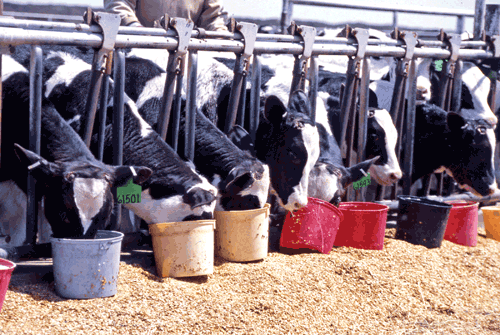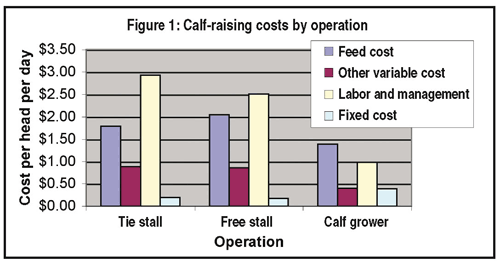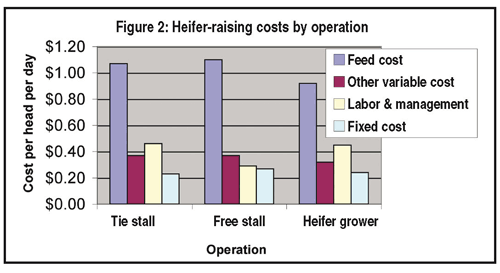by David Jones, Mark Hill, and Rick Schlotterbeck
The authors are with Akey Research and Technology Center, Lewisburg, Ohio.

Many calves get replacer or milk much longer than they need to.
Earlier weaning has been shown to work in trials and on farms.
Try moving up weaning on a group of calves.
Early weaning is not a new concept. There are a dozen or so peer-reviewed research publications that show its success dating back to about 1970. Recent research from Penn State has reported successful weaning as early as 3 weeks of age when a 22 percent crude protein milk replacer powder was fed at 1.25 percent of body weight or just over 1 pound of powder daily.
The advantages of early weaning are that there's a lot less time spent feeding calves, and you spend a lot less on replacer. However, the most recent U.S. survey listed the average weaning age of calves to be 8.4 weeks or 59 days of age, and it is similar in many other countries. So, there are plenty of farms that could move up weaning.
Arguments against . . .
Since many controlled research trials show that early weaning is successful, why do so many people around the world not implement it? We think there are at least five reasons (doubt, excess waste milk, the accelerated calf growth concept, tradition, and poor calf care).
Doubt is the calf raiser thinking that the 30 to 100 calves used in a research trial is too small a number to convince them that the system really will work on their farm.
Yes, many trials use only a few calves. However, if this research has been published in a peer-reviewed journal (where the research is reviewed by expert researchers in the field of calf nutrition and management), then it should have been carefully controlled research. With controlled research, typically a few calves should be adequate to measure differences in performance. We have published early-weaning research in a peer-reviewed journal, as well. It supported the early- weaning concept.
We also have collected data from 3,300 calves fed at conventional and moderately accelerated milk replacer programs and weaned at either 4 or 6 weeks. More than 94 percent of the calves in a conventional system were weaned on time with a four-week weaning program (Table 1).

More than 99 percent of the calves in a moderately accelerated milk replacer program were weaned successfully with a four-week weaning program. There is no doubt that early-weaning programs can be made to work.
Waste milk not free . . .
Excess waste milk is a milk quality issue on the dairy that leads to a lot of waste milk that can be fed to calves and which appears as "free feed."
If a farm has so much excess waste milk that it can feed 1 to 2 gallons per calf daily (equal to 1 to 2 pounds of milk replacer powder) for six or more weeks, then it has a very pressing milk quality problem. The economics of this make the partial budget of the calf enterprise look good, despite the biosecurity risk, while the economics of the milking herd enterprise does not look so good.
The accelerated calf growth concept is based on feeding calves more, not less milk replacer.
This concept, reintroduced in the late 1990s by Cornell University, strongly suggests that calves need more protein and energy than provided by 1 gallon of milk or 1 pound of milk replacer powder daily. It is a correct concept. However, this program also can be managed as a moderate-accelerated program feeding 1.5 pounds of a 26 percent protein, 17 percent fat milk replacer powder per calf daily. It can be more economical and provide similar-sized calves at 8 to 12 weeks of age as programs feeding 2 to 3 pounds of powder daily.
The more moderate amount of a high-protein powder allows the calves to consume starter, develop a rumen, and wean normally without slumps in growth at and after weaning time. As previously mentioned, more than 99 percent of the calves were weaned successfully at 4 weeks of age in this program (Table 1).
Note in Table 2 that calves in this program consume starter and grow faster than calves fed a conventional program. Also, note in Table 2 that calves weaned early in the program grow about as fast as calves weaned later.

Old habits . . .
Tradition is the notion that this is the way that it always has been done on a farm, so why change.
"We have always done it this way" is not an acceptable approach to management. If you are accustomed to weaning calves at 8 weeks, then you can begin by weaning at 7 weeks. Once you've established successful 7-week weaning, you can implement a 6-week weaning program. The weeks to weaning can be gradually reduced as you gain confidence in the change.
Poor calf care is related to someone experiencing a lot of health challenges in calves and doubting that a system where less milk or milk replacer is fed actually will work for them.
If having calf-raising problems is limiting your calf program and limited the ability to wean early, then again, this is not an acceptable management approach. Overcome the poor management. If standard, written calf management procedures do not exist, create them.
Consultants, companies, and universities can provide examples of written management procedures that farms can adapt to their situation. Find an experienced calf professional, not already familiar with your farm, to carefully observe your calf management and offer suggestions for improvement.
These procedures and their implementation will help your calf care improve.
They make it work . . .
Ken Leu and Judy Steinke, Waupun, Wis., wean approximately 2,000 calves annually. They are custom calf raisers for a dairy about three hours from their operation. About half the calves arrive with serum protein concentrations less than 5.5 mg per dL (marginal to low in serum protein). Yet, for eight years now, they have been successfully using a 26 percent crude protein, 17 percent fat milk replacer that has been fed at 1.5 pounds daily.
Their bull calves wean at about 28 days; their heifers at about 35. At 14 weeks, when the calves leave their facility, the bulls have gained 2.8 pounds of body weight per day, and the heifers have gained 2.3 pounds per day.
Early weaning programs are successful in weaning a very high percentage of calves. Moderately accelerated-program calves can be weaned successfully and do not sacrifice the added growth that these programs yield verses conventional programs.
Money and time are always short. Early weaning reduces both without adding risk to calf raising. Why not give it a try on a few calves?
Click here to return to the Calf & Heifer E-Sources
080210_108
The authors are with Akey Research and Technology Center, Lewisburg, Ohio.

Earlier weaning has been shown to work in trials and on farms.
Try moving up weaning on a group of calves.
Early weaning is not a new concept. There are a dozen or so peer-reviewed research publications that show its success dating back to about 1970. Recent research from Penn State has reported successful weaning as early as 3 weeks of age when a 22 percent crude protein milk replacer powder was fed at 1.25 percent of body weight or just over 1 pound of powder daily.
The advantages of early weaning are that there's a lot less time spent feeding calves, and you spend a lot less on replacer. However, the most recent U.S. survey listed the average weaning age of calves to be 8.4 weeks or 59 days of age, and it is similar in many other countries. So, there are plenty of farms that could move up weaning.
Arguments against . . .
Since many controlled research trials show that early weaning is successful, why do so many people around the world not implement it? We think there are at least five reasons (doubt, excess waste milk, the accelerated calf growth concept, tradition, and poor calf care).
Doubt is the calf raiser thinking that the 30 to 100 calves used in a research trial is too small a number to convince them that the system really will work on their farm.
Yes, many trials use only a few calves. However, if this research has been published in a peer-reviewed journal (where the research is reviewed by expert researchers in the field of calf nutrition and management), then it should have been carefully controlled research. With controlled research, typically a few calves should be adequate to measure differences in performance. We have published early-weaning research in a peer-reviewed journal, as well. It supported the early- weaning concept.
We also have collected data from 3,300 calves fed at conventional and moderately accelerated milk replacer programs and weaned at either 4 or 6 weeks. More than 94 percent of the calves in a conventional system were weaned on time with a four-week weaning program (Table 1).

More than 99 percent of the calves in a moderately accelerated milk replacer program were weaned successfully with a four-week weaning program. There is no doubt that early-weaning programs can be made to work.
Waste milk not free . . .
Excess waste milk is a milk quality issue on the dairy that leads to a lot of waste milk that can be fed to calves and which appears as "free feed."
If a farm has so much excess waste milk that it can feed 1 to 2 gallons per calf daily (equal to 1 to 2 pounds of milk replacer powder) for six or more weeks, then it has a very pressing milk quality problem. The economics of this make the partial budget of the calf enterprise look good, despite the biosecurity risk, while the economics of the milking herd enterprise does not look so good.
The accelerated calf growth concept is based on feeding calves more, not less milk replacer.
This concept, reintroduced in the late 1990s by Cornell University, strongly suggests that calves need more protein and energy than provided by 1 gallon of milk or 1 pound of milk replacer powder daily. It is a correct concept. However, this program also can be managed as a moderate-accelerated program feeding 1.5 pounds of a 26 percent protein, 17 percent fat milk replacer powder per calf daily. It can be more economical and provide similar-sized calves at 8 to 12 weeks of age as programs feeding 2 to 3 pounds of powder daily.
The more moderate amount of a high-protein powder allows the calves to consume starter, develop a rumen, and wean normally without slumps in growth at and after weaning time. As previously mentioned, more than 99 percent of the calves were weaned successfully at 4 weeks of age in this program (Table 1).
Note in Table 2 that calves in this program consume starter and grow faster than calves fed a conventional program. Also, note in Table 2 that calves weaned early in the program grow about as fast as calves weaned later.

Old habits . . .
Tradition is the notion that this is the way that it always has been done on a farm, so why change.
"We have always done it this way" is not an acceptable approach to management. If you are accustomed to weaning calves at 8 weeks, then you can begin by weaning at 7 weeks. Once you've established successful 7-week weaning, you can implement a 6-week weaning program. The weeks to weaning can be gradually reduced as you gain confidence in the change.
Poor calf care is related to someone experiencing a lot of health challenges in calves and doubting that a system where less milk or milk replacer is fed actually will work for them.
If having calf-raising problems is limiting your calf program and limited the ability to wean early, then again, this is not an acceptable management approach. Overcome the poor management. If standard, written calf management procedures do not exist, create them.
Consultants, companies, and universities can provide examples of written management procedures that farms can adapt to their situation. Find an experienced calf professional, not already familiar with your farm, to carefully observe your calf management and offer suggestions for improvement.
These procedures and their implementation will help your calf care improve.
They make it work . . .
Ken Leu and Judy Steinke, Waupun, Wis., wean approximately 2,000 calves annually. They are custom calf raisers for a dairy about three hours from their operation. About half the calves arrive with serum protein concentrations less than 5.5 mg per dL (marginal to low in serum protein). Yet, for eight years now, they have been successfully using a 26 percent crude protein, 17 percent fat milk replacer that has been fed at 1.5 pounds daily.
Their bull calves wean at about 28 days; their heifers at about 35. At 14 weeks, when the calves leave their facility, the bulls have gained 2.8 pounds of body weight per day, and the heifers have gained 2.3 pounds per day.
Early weaning programs are successful in weaning a very high percentage of calves. Moderately accelerated-program calves can be weaned successfully and do not sacrifice the added growth that these programs yield verses conventional programs.
Money and time are always short. Early weaning reduces both without adding risk to calf raising. Why not give it a try on a few calves?
080210_108








